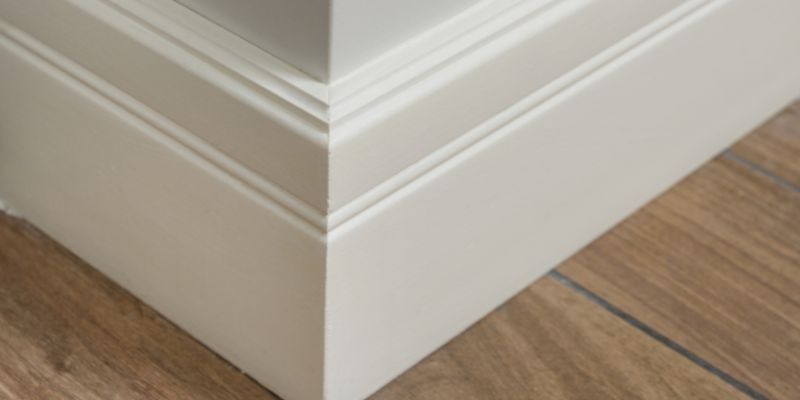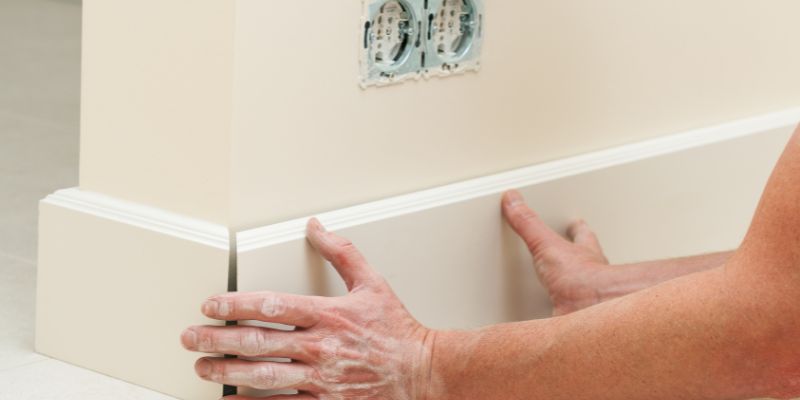To cut baseboard corners, use a miter saw to make a 45-degree angle cut on each end of the baseboard piece. Then, fit the two pieces together for a seamless corner joint.
Cutting baseboard corners requires precise measurements and careful alignment to ensure a professional finish. By following the proper technique, you can achieve clean and accurate corner cuts for your baseboard installation project. Creating precise and seamless corners on baseboards is an essential aspect of finishing carpentry.
Whether you are renovating your home or working on a new construction project, understanding how to cut baseboard corners correctly is crucial for achieving a polished and professional look. We will explore the step-by-step process of cutting baseboard corners using a miter saw and provide helpful tips for achieving flawless results.
Essential Tools For Baseboard Cutting
When it comes to cutting baseboards, having the right tools is essential for achieving clean and precise corners. The process of cutting baseboard corners requires specific tools that serve different purposes. Understanding the role of each tool and having the proper equipment is crucial for achieving professional-looking results. In this section, we will explore the essential tools required for cutting baseboards, the role of each tool, and recommended brands.

List Of Necessary Tools For Cutting Baseboards
Before embarking on any baseboard cutting project, it’s crucial to have the following tools handy:
- Miter saw
- Miter box and hand saw
- Coping saw
- Combination square
- Tape measure
- Pencil
- Clamps
- Safety goggles and dust mask
Understanding The Role Of Each Tool
Each tool plays a specific role in the baseboard cutting process. Understanding the purpose of each tool is essential for achieving accurate and clean cuts:
| Tool | Role |
|---|---|
| Miter saw | Used for cutting precise 45-degree angles for inside and outside corners |
| Miter box and hand saw | Alternative to a miter saw for cutting angles on smaller baseboard pieces |
| Coping saw | For cutting intricate profiles and coping the ends of baseboards for seamless joints |
| Combination square | Ensures accurate measurements and helps in marking the cut lines |
| Tape measure and pencil | For measuring and marking the baseboard for accurate cuts |
| Clamps | Secure the baseboard in place for safe and precise cutting |
| Safety goggles and dust mask | Protective gear for safety during cutting and to minimize exposure to sawdust |
Recommended Brands And Where To Find Them
When it comes to selecting tools for baseboard cutting, reputable brands ensure quality and reliability. Some recommended brands for baseboard cutting tools include:
- DeWalt: Known for durable miter saws and high-quality hand tools
- Bosch: Offers a range of miter saws and measuring tools
- Irwin: Provides reliable clamps and cutting tools
- Stanley: Known for their combination squares and hand tools
You can find these reputable brands at major home improvement stores, online retailers, and specialty tool shops.
Preparing To Cut Baseboard Corners
When preparing to cut baseboard corners, it’s essential to ensure accurate measurements, stability, and clear markings for a professional finish. Here are the steps to follow for preparing to cut baseboard corners:
Measuring The Corner Angles Accurately
Before you start cutting your baseboard corners, it’s crucial to measure the corner angles accurately. Use an angle finder or a combination square to determine the angle of the corner. Place the tool against the wall and the baseboard to get an exact measurement, ensuring precise angles for a perfect fit.
Clamping The Baseboards For Stability
Once you have the measurements, it’s important to secure the baseboard in place for stability during the cutting process. Use clamps to hold the baseboard firmly against the saw’s fence, preventing any movement that could lead to inaccurate cuts. This step ensures that the baseboard remains steady and secure, resulting in clean and precise cuts.
Marking The Cut Lines Clearly
After securing the baseboard, mark the cut lines clearly to indicate where the cuts will be made. Use a pencil or a sharp knife to create unmistakable lines that will guide your saw. Clear markings help prevent errors and ensure that each cut is made accurately, contributing to a seamless installation of the baseboard.
Expert Tips: How To Cut Baseboard Corners
Cutting baseboard corners may seem daunting, but with the right techniques and precision, you can achieve seamless and professional-looking results. Here are some expert tips on how to cut baseboard corners effectively.
Choosing Between Miter Cuts And Coping For Inside Corners
When dealing with inside corners, you have the option of using either miter cuts or coping. Miter cuts involve cutting the baseboard at a 45-degree angle, while coping involves cutting the profile of the baseboard to fit over the profile of the adjacent baseboard. Both techniques have their advantages, with miter cuts being suitable for simpler corners, and coping offering better results for tighter inside corners.
The Importance Of Precise Angles In Miter Cuts
Precise angles are crucial when making miter cuts for baseboard corners. Any deviation from the accurate angle can result in unsightly gaps and misaligned corners. To ensure precise angles, using a quality miter saw and accurately measuring and marking the baseboard will be key to achieving a perfect fit.
Coping Technique For Tighter Inside Corner Joints
The coping technique is particularly useful for achieving a seamless fit at tighter inside corner joints. By carefully cutting the profile of the baseboard to match the profile of the adjacent piece, you can create a snug and professional-looking joint. This technique requires precision and attention to detail, but the results can significantly enhance the overall appearance of the baseboard corners.
Seamless Outside Corner Trims
Calculating The Correct Angles For Outside Corners
When it comes to achieving seamless outside corner trims, it’s crucial to calculate the correct angles for outside corners. This ensures a precise fit and a professional finish. Let’s delve into the process of calculating the angles for outside corners to achieve a flawless result.
Tips For Cutting Without Splintering The Wood
When cutting baseboard corners, it’s essential to utilize techniques that minimize splintering and ensure clean, sharp edges. Here are some effective tips for cutting baseboard corners without splintering the wood:
- Use a sharp, fine-toothed saw to produce clean cuts without splintering the wood.
- Apply painter’s tape along the cutting line to reduce splintering during the cutting process.
- Support the baseboard securely to prevent vibration, which can lead to splintering during cutting.
Sanding And Finishing Cuts For A Polished Look
After cutting baseboard corners, it’s important to sand and finish the cuts to achieve a polished and professional appearance. Implement the following steps to ensure a refined finish:
- Sand the edges: Utilize fine-grit sandpaper to smooth the cut edges and remove any roughness or splinters.
- Apply wood filler: Fill any gaps or imperfections with wood filler, then sand the filled areas to create a seamless surface.
- Use a primer and paint: Apply a high-quality primer and paint to the baseboards, ensuring a consistent and polished look for the finished corners.
Achieving Flawless Results Every Time
When it comes to cutting baseboard corners, achieving flawless results every time requires the right techniques and attention to detail. By mastering the following steps, you can elevate the appearance of your space with perfectly installed baseboards.
Techniques For Aligning And Securing Baseboards
Aligning and securing baseboards is crucial for a professional-looking finish. Achieve seamless corners by:
- Using a miter saw to cut precise 45-degree angles for inside corners and 22.5-degree angles for outside corners.
- Using a coping saw to carefully remove material from the back of one baseboard to create a snug fit with the intersecting board.
- Securing baseboards with precision by using a finishing nail gun and ensuring a flush fit against the wall.
Filling And Caulking For A Professional Finish
To create a seamless appearance, the following steps are essential for filling and caulking baseboard corners:
- Fill any gaps or nail holes with a high-quality wood filler, ensuring a smooth and even application.
- Apply a bead of caulk along the top and bottom edges of the baseboards, then use a caulk smoothing tool to achieve a clean finish.
- Wipe away any excess caulk with a damp cloth and allow it to dry completely before touching up with paint.
Painting And Touch-up Strategies For Baseboards
Proper painting and touch-up techniques are essential for flawless baseboard corners:
- Before painting, use painter’s tape to protect adjacent surfaces and achieve clean lines.
- Apply primer to the baseboards to ensure an even base for the final coat of paint.
- Paint the baseboards with a high-quality trim paint, using smooth, even strokes to achieve a professional finish.
- After the paint has dried, inspect the corners for any imperfections and touch up as needed for a perfectly polished appearance.

Frequently Asked Questions On How To Cut Baseboard Corners
How Do You Cut Baseboard Corners With A Miter Saw?
To cut baseboard corners with a miter saw, measure and mark the angle, position the baseboard against the saw, and make the cut following the marked angle. Ensure a proper hold and safety precautions when cutting.
What Is The Best Way To Cut Inside Baseboard Corners?
The best way to cut inside baseboard corners is by using a miter saw or a coping saw. Both methods allow for precise cuts that fit snugly against the adjacent baseboard, ensuring a professional finish.
Can I Use A Coping Saw To Cut Baseboard Corners?
Yes, a coping saw is an excellent tool to cut baseboard corners, especially for inside corners. This method allows for precise cuts that can be easily shaped to fit against the adjoining baseboard, resulting in a seamless joint.
What Angle Do I Cut Baseboard Corners For A 90-degree Corner?
For a 90-degree corner, you will need to cut your baseboard at 45-degree angles. This will ensure a clean and professional-looking joint when the baseboards are fitted together at a right angle. Use a miter saw for precise cuts.
Conclusion
In wrapping up, mastering the art of cutting baseboard corners is an essential skill for any DIY enthusiast or professional carpenter. With the right tools, techniques, and attention to detail, you can achieve precise and seamless corner cuts that will elevate the overall look of your space.
Practice makes perfect, so don’t be afraid to dive in and refine your abilities. With these tips in mind, you’ll be cutting baseboard corners like a pro in no time!



2 thoughts on “How to Cut Baseboard Corners: Expert Tips for Flawless Results”